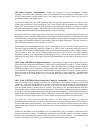32
As and example again lets say we have +6 dbm, we divide 6 by 10 to get .6 and using our calculator get the
anti log as 3.98 on my HP 25 calculator, which is nearly 4, and multiply it by our reference of one mw and
have 4 mw of power equal to +6dbm. If it were –6dbm the ratio would be negative, -.6, and the anti log
would be .25, which is .25 mw since PR is in miliwatts.
To get a physical feel for ratio’s in db’s compared to the linear number ratios they represent lets look at the
following linear number ratios and their corresponding values in the logarithmic ratio of db’s:
NUMBER RATIO POWER DB RATIO
0 0db
2 3db
4 6db
6 8db
8 9db
10 10db
100 20db
1000 30db
In this table I rounded off the values to the nearest db. As you can see from this little table the logarithmic
db ratio will increase more rapidly than the linear ratio at first then match it at 10 and 10db then increase
much more slowly over ten. In the real world the log ratio is the way we experience many physical things
like how we sense sound. We sense more in a logarithmic ratio than in the actual linear ratio. In other
words a sound power increase of 4 time will sound 6 times louder where a sound power increase of 1000
will only sound 30 times louder, no wonder people go deaf at rock concerts. The db logarithmic system
does a better job of showing the importance of measurement levels in the real world and that’s why it’s
often used when dealing in levels over a very wide range in electronic measurements. Also notice that 0db
is 1, and with positive db values we can’t express numbers below one like fractions. But using negative
db’s does this for us, but more on this later.
To help understand what an instrument reading means, I get a feel for the linear magnitude of a decibel
ratio the following easy way. For values under 10db we can memorize some key linear values to get a feel
for the linear ratio values. For every db value of ten or over first ignore the first LSD, take the remaining
significant digits and raise ten to the power of the number of digits, like in our table for 10db and raise ten
to the first power which is 10, then for 20db raise 10 to the 2
nd
power which is 100 or if you had 60db raise
10 to the 6
th
power you have 1,000,000 or one million. 120db would be ten to the 12
th
power.
Now there is even an easier way, by adding zeros behind one. Take 30db, write down a 1 and put 3 zeros
behind it and you get 1000. Or 120db write 1 and put 12 zeros behind it 1,000,000,000,000, boy that’s
sure a big number we can express with a much smaller one.
Next take the first LSD digit and multiply the MSD’s value by its linear value to get the total ratio number.
Take 23db, we first compute 100 for the MSD value, then using our table we find the LSD value for 3db is
2 and then multiply 2 X 100 to get 200. Or for 39db, take 1000 for the MSD value multiply it by the LSD
of 9db, which is 8, to get the total take 1000 X 8 or 8000. As you can see by this simple calculation and
knowing many of the db values between 0 and 10, you can make a quick estimate of the linear number
ratio of a number in db’s.
You can also compute –db ratios in a similar manner by remember they express linear ratios less than 1. In
other words –3db is ½ or .5, -10db is .1, and –30db is .001. The rule for estimating – db’s is to take the
MSD’s as one less than the number of zeros to the right of the decimal point. –30db would be .001, two
zeros, and -60db would be .000001, five zeros. For –db’s that the LSD value is not zero, just divide the
linear value of the LSD to the linear value of the MSD’s. –26db would be .01 divided by 4 or .0025. As
you can see it’s also easy to estimate linear ratio values from –db’s.


















